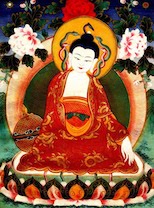Koso Wasan 10
But the attractions of affection were extremely hard to sever,
And birth-and-death was extremely difficult to exhaust.
Only by practicing the nembutsu-samadhi,
Could we eliminate the obstructions of karmic evil and gain
liberation.'
The Pure Land Way

This verse continues the reflection on the quotation from Bodhisattva Nagarjuna's Daichido Ron edited by the later Pure Land master, Tao ch'o (562 - 645), and included in his major work the Anraku Shu. Shinran Shonin's perspective in relation to it is deeply moving and full of pathos.
By the sixth century of the common era, a flourishing tradition had developed in support of the fledgeling Pure Land school, for which Tao-ch'o was to become an especially eloquent and important spokesman. This tradition included material attributed to both Nagarjuna and Vasubandhu, who were seen, correctly, as the source of much of the theory that underpins practice in the path of sages. In the Kyo Gyo Shin Sho, Shinran even uses Madhyamika sources1 in support of the Pure Land teaching to throw light on his religious experience.
As we can see from the Dasha Bhumi of Nagarjuna, until the time of Shan-tao, the Pure Land way was seen as a hedge against personal failure in practical endevours and not as an integrated self-referencing system. Although those who turned to the Pure Land way came from various philosophical schools, it was not the primary focus in their pursuit of the dharma. The effect of this, I believe, has been the maintenance of the Pure Land stream as a teaching with roots deep in the original ethos of the dharma, floating free of the constraints and rigidities of specific later, so-called philosophical schools of thought.
There is no doubt that all systems of thought within the Buddha Dharma are intended to serve as a vehicle for the final transcendence of samsara and the ultimate freedom and relief of those who take up the way. The Pure Land way is no less a part of this objective. But even by Shinran's time it seems still to have retained its essential pre-philosophical ethos.
It seems to me that the truth about the Mahayana is that the great systems of thought and practice, like Madhyamika, are designed to underpin specific practices associated directly with their particular methodology. In this sense, then, saying the nembutsu is more or less irrelevant to them and the philosophy of extraneous schools is ultimately only decorative and essentially useless in the task of justifying or supporting nembutsu practice.
One can not stress enough the fact that, in Buddhism, philosophy and psychology are inevitably tied to a practice; and that, without the practice, the theory - the philosophy - serves no purpose. In fact, the Pure Land way goes to the heart of the matter and lands the follower firmly at the feet of the basic and unmitigated principles of the dharma which were first expounded by Shakyamuni himself - conditioned things have no self (Sk. anatman), all conditioned things are subject to change (Sk. anitya), all existence is painful (Sk. dhukha) and there is no bliss except nirvana. Ultimately, the Pure Land way points directly and unapologetically to nirvana, the unconditioned.
1: For example CWS, p. 241-2.